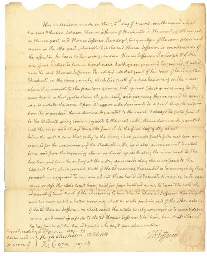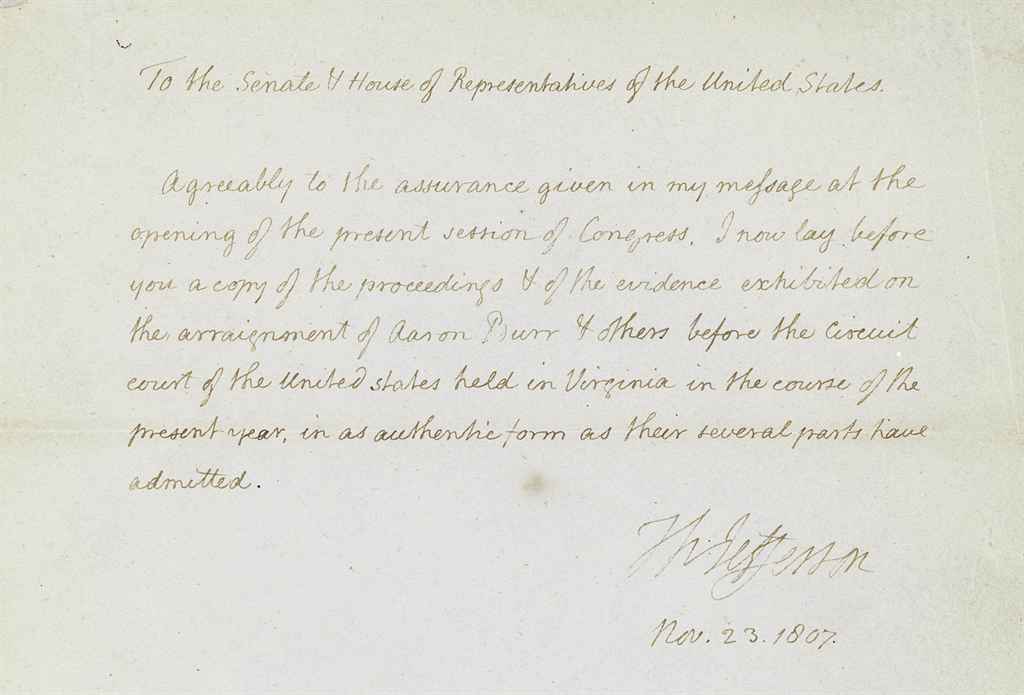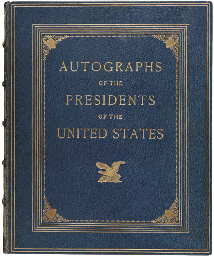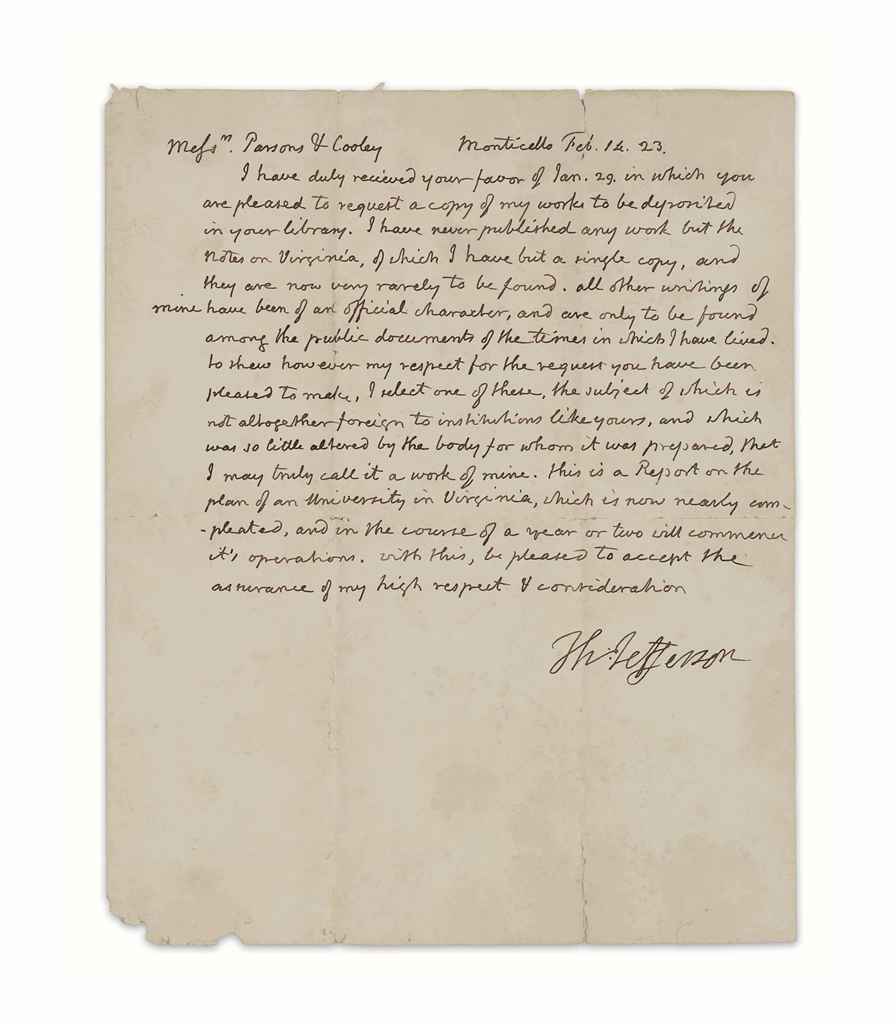JEFFERSON, Thomas. Autograph document signed ("Th:Jefferson Rector"), as Rector of the University of Virginia, with his name appearing in full in the first line of text, no place, 12 May 1823. 2 pages, 4to (10¼ x 7 7/8 in), small cancellation punch affecting the "fe" in signature, with a fine, crisp paper impression of the circular seal of the Rector and Board of Visitors (a standing woman holding olive branch aloft in one hand, supporting a cornucopia with the other, legend UNIVERSITY and date "1819"). FINANCING THE UNIVERSITY: A LOAN TO FINISH THE BUILDINGS OF THE UNIVERSITY OF VIRGINIA AND FOR "PUTTING THE UNIVERSITY INTO OPERATION" A promissory note entirely drafted by Jefferson, spelling out financial details of a loan to complete the final preparations for the University of Virginia, the educational vision to which the former President dedicated himself tirelessly during the years of his retirement. The document records a loan for the completion of construction of the "academical village" at Charlottesville, scheduled to accept its first matriculated students in the Spring of 1825. It reads: "Know all men by these presents that we Thomas Jefferson rector and James Breckingride, James Madison, Joseph C. Cabell, John H. Cocke, Chapman Johnson and George Loyall, Visitors of the University of Virginia are held and firmly bound to the President and Directors of the Literary Fund in the sum of [$60,000] to the payment whereof...we bind ourselves...by these presents, sealed with the common seal of the Rector and Visitors..." The contract derives from an act of the Virginia assembly of 5 February "entitled 'An Act concerning the University of Virginia, and for other purposes' (passed in 1821), authorizing the Board of Visitors to borrow up to $60,000. Accordingly, the President and Directors of the Literary Fund have loaned the Rector and Visitors the sum of $30,000 "for the purposes of completeing the buildings and making the necessary preparations for putting the university into operation." Interest on the loan is specified to be 6 per annum, to be paid out of the annual appropriation for the endowment of the University, as stipulated by law, and the Rector and Visitors undertake that they will pay the interest annually "and shall also pay the principal sum...according to the provisions of the s[ai]d act." In addition, Jefferson's contract provides, the funds necessary are hereby "pledged and set apart by the s[ai]d Rector and Visitors to be applied to the President and Directors of the Literary Fund...and to no other use or objects until the s[ai]d payment shall have been made...then the above obligation shall be void..." The signatures of George E. Walsh and L.H. Marstetter are added at end as witnesses to the bond. Their signatures and Jefferson's are neatly lined through to certify payment of the debenture, while Jefferson's signature has been additionally cancelled by a small ( 3/16 in. diameter) punch, a common practice on many types of financial instruments in this period. Jefferson's himself surveyed the site for the University and staked out the laid the buildings (which he designed) and selected the books for the new library. But his ambitious plans placed a heavy financial burden upon the state. "From beginning to end a grudging legislature offered the main obstacle to Jefferson's plans for the university," and "Jefferson and his friend waged a relentless five-year campaign to obtain the money" (M.D. Peterson, Thomas Jefferson and the New Nation , pp.980-981). The Library in particular proved susceptible to cost over-runs. Its splendid rotunda "was the capstone of his university, and it is the masterpiece of his career...combining utility with...aesthetic philosophy" (W.H. Adams, The Eye of Thomas Jefferson , Washington: National Gallery, 1976, p.284). By 1824, though, the grand project was so far advanced that "the momentum of the enterprise had passed the point where anyone but a foolish spendthrift would dema
JEFFERSON, Thomas. Autograph document signed ("Th:Jefferson Rector"), as Rector of the University of Virginia, with his name appearing in full in the first line of text, no place, 12 May 1823. 2 pages, 4to (10¼ x 7 7/8 in), small cancellation punch affecting the "fe" in signature, with a fine, crisp paper impression of the circular seal of the Rector and Board of Visitors (a standing woman holding olive branch aloft in one hand, supporting a cornucopia with the other, legend UNIVERSITY and date "1819"). FINANCING THE UNIVERSITY: A LOAN TO FINISH THE BUILDINGS OF THE UNIVERSITY OF VIRGINIA AND FOR "PUTTING THE UNIVERSITY INTO OPERATION" A promissory note entirely drafted by Jefferson, spelling out financial details of a loan to complete the final preparations for the University of Virginia, the educational vision to which the former President dedicated himself tirelessly during the years of his retirement. The document records a loan for the completion of construction of the "academical village" at Charlottesville, scheduled to accept its first matriculated students in the Spring of 1825. It reads: "Know all men by these presents that we Thomas Jefferson rector and James Breckingride, James Madison, Joseph C. Cabell, John H. Cocke, Chapman Johnson and George Loyall, Visitors of the University of Virginia are held and firmly bound to the President and Directors of the Literary Fund in the sum of [$60,000] to the payment whereof...we bind ourselves...by these presents, sealed with the common seal of the Rector and Visitors..." The contract derives from an act of the Virginia assembly of 5 February "entitled 'An Act concerning the University of Virginia, and for other purposes' (passed in 1821), authorizing the Board of Visitors to borrow up to $60,000. Accordingly, the President and Directors of the Literary Fund have loaned the Rector and Visitors the sum of $30,000 "for the purposes of completeing the buildings and making the necessary preparations for putting the university into operation." Interest on the loan is specified to be 6 per annum, to be paid out of the annual appropriation for the endowment of the University, as stipulated by law, and the Rector and Visitors undertake that they will pay the interest annually "and shall also pay the principal sum...according to the provisions of the s[ai]d act." In addition, Jefferson's contract provides, the funds necessary are hereby "pledged and set apart by the s[ai]d Rector and Visitors to be applied to the President and Directors of the Literary Fund...and to no other use or objects until the s[ai]d payment shall have been made...then the above obligation shall be void..." The signatures of George E. Walsh and L.H. Marstetter are added at end as witnesses to the bond. Their signatures and Jefferson's are neatly lined through to certify payment of the debenture, while Jefferson's signature has been additionally cancelled by a small ( 3/16 in. diameter) punch, a common practice on many types of financial instruments in this period. Jefferson's himself surveyed the site for the University and staked out the laid the buildings (which he designed) and selected the books for the new library. But his ambitious plans placed a heavy financial burden upon the state. "From beginning to end a grudging legislature offered the main obstacle to Jefferson's plans for the university," and "Jefferson and his friend waged a relentless five-year campaign to obtain the money" (M.D. Peterson, Thomas Jefferson and the New Nation , pp.980-981). The Library in particular proved susceptible to cost over-runs. Its splendid rotunda "was the capstone of his university, and it is the masterpiece of his career...combining utility with...aesthetic philosophy" (W.H. Adams, The Eye of Thomas Jefferson , Washington: National Gallery, 1976, p.284). By 1824, though, the grand project was so far advanced that "the momentum of the enterprise had passed the point where anyone but a foolish spendthrift would dema








.jpg)






Testen Sie LotSearch und seine Premium-Features 7 Tage - ohne Kosten!
Lassen Sie sich automatisch über neue Objekte in kommenden Auktionen benachrichtigen.
Suchauftrag anlegen